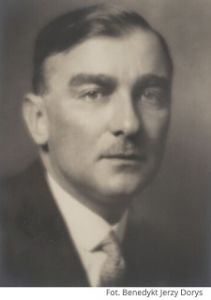Szymanowski Karol
-
Composer
In 1917 the Bolshevik October Revolution forced the composer to leave his native Tymoszówka forever. He moved to Elisavetgrad, and in 1919 he settled in Warsaw. In 1921, together with Paweł Kochański and Artur Rubinstein, he travelled to the United States; in May 1922, his composer concert in Paris received an enthusiastic response. In August 1922, he visited Zakopane for the first time after World War I, and from that moment on he was a regular guest there. His artistic interests increasingly focused on Polish folk music, particularly that of the Podhale region at the foot of the Tatra and Kurpie north of Warsaw. In 1926, he turned down the post of director in Cairo Conservatory, and instead, from 22nd February 1927 till 31st August 1929, he was the rector of the Conservatory in Warsaw. In 1929, he received treatment in the Edlach Sanatorium in Austria, later – in Davos in Switzerland. From 1st September 1930 till 30th April1932, he was the vice-chancellor of the Higher School of Music in Warsaw. In 1930 he took permanent residence in Zakopane, in “Villa Atma” . In 1933-36, he performed his own works in France, Belgium, the Netherlands, England, Italy, Yugoslavia, Bulgaria, Germany, Sweden, Denmark, Norway and the Soviet Union. The two greatest Polish 20th-century composers, Karol Szymanowski and Witold Lutosławski, met only once in their lifetime – in 1935. In November that year, Szymanowski left “Atma”, never to return. He stayed several times in the French sanatorium in Grasse, and in March 1937 he died in a sanatorium in Losanne.
Karol Szymanowski’s numerous awards and distinctions included: The Officer’s and Commander’s Crosses of the Order of Polonia Restituta, The Italian Royal Officer’s and Commander’s Orders, the Honorary Order Regia Accademia di Santa Cecilia, the Academic Gold Laurel Wreath of the Polish Academy of Literature, an honorary doctorate of the Jagiellonian University in Cracow and the honorary memberships of České Akademie Véd a Uméni, the Latvian Music Conservatory in Riga, St Cecilia Royal Academy in Rome, Royal Academy of Music in Belgrade, and the International Society for Contemporary Music. In 1935, he was presented with the State Music Award.
A website dedicated to the composer: www.karolszymanowski.pl
Creation
In Simon Rattle’s opinion, such works by Szymanowski as his violin concertos or Sinfonia concertante should have become a staple of the violin and piano repertoires worldwide already a long time ago. The two or three dozen pieces once recorded by Toscanini are simply not enough. The public is open to a new repertoire, as borne out by the phenomenal success of Górecki, enthusiastically greeted not only by the traditional philharmonic audiences. Górecki now has his fans in Britain among people who have never listened to classical music before; Szymanowski could make a comparable impact.
Simon Rattle discovered Symphony No. 3 owing to Witold Lutosławski, whom this very composition had once inspired to become a composer. Rattle sees the Symphony No. 3 as a wondrous mystical piece expressing a fascination with the East, a composition whose atmosphere answers the needs of a contemporary audience. Nonetheless, he believes that Szymanowski’s later works, which mark his return to Polish tradition, even to Slavic roots, with something like a reference to Mussorgsky, are even more important for present-day culture. Towards the end of the 20th century, the rest of the world must finally discover what Poles have known since the beginning: Szymanowski was one of the century’s greatest composers (“Studio” 1994 No. 10).
Another world-famous conductor, Charles Dutoit, recorded both of Karol Szymanowski’s violin concertos with the Orchestre Symphonique de Montréal and the Canadian violinist Chantal Juillet. The record was released in 1994 by Decca. Dutoit found Szymanowski’s music very much to his taste, because it is extremely colourful, full of wonderful colours – and in this sense it does not really sound like most Central European music. He believes his orchestra plays it quite well. They have already performed many of Szymanowski’s works. Apart from the violin concertos with Madame Juillet, with which they have toured all over the world, including even Buenos Aires and Tokyo, they have also played the Symphonies No. 3 and No. 4, Concert Overture, Stabat Mater, in fact – the vast majority of his orchestral works. This music is not very popular yet, but its time is coming. Dutoit himself has long been fascinated with it. He conducted Szymanowski with all the major American orchestras, including New York Philharmonic, Boston Symphony Orchestra, Philadelphia Orchestra. Still as a violinist, he performed The Fountain of Arethusa from Myths; it is one of those works which every violinist ought to play. Also wonderful is the Violin Sonata, and he is fond of both of his quartets. He is also familiar with some of Szymanowski’s piano music (“Studio” music magazine, 1994 No. 9).
It seems that the time for Szymanowski’s music has eventually come. Today it finds its way concert halls and operatic stages more and more frequently. One of the major factors that have contributed to the present-day renaissance of Szymanowski’s art worldwide is his opera King Roger, which is coming to be seen as the most successful Polish opera of all time. The work was written in 1918-1924 to a libretto by the eminent Polish writer Jarosław Iwaszkiewicz, when Szymanowski – having gone through a period of fascination with German neo-Romanticism – was seeking new inspirations. In 1914 he made a journey to Italy, Sicily and North Africa, which proved very important for his artistic development. On his way back, he stopped off in Paris, where he became acquainted with the works of Debussy and Ravel. The works which resulted from these influences were largely influenced by impressionism, exotic cultures and the Antiquity. Exotic and ancient cultures are the topics, but there are also elements of stylisation and the sound becomes impressionist in character. Szymanowski simplifies the texture of his works, abandons the dense polyphonic interplay of many melodic motifs, but without rejecting the melody itself, which he now presents against the background of colouristically varied harmonies, so characteristic of impressionism, which, emphasising the impressive nature of sound, puts harmony in the foreground while reducing the melody. Szymanowski combines the impact of harmony with an active role of the melody, which gives his “impressionism” an individual strain, distinguishing him from other European composers influenced by this trend. All of these features of Szymanowski’s musical language are distinctly present in King Roger, which, alongside the subject of the opera, creates its unique character and originality. There are elements of musical drama in the form of leitmotifs, but also – of the opera (independent self-contained scenes which arrest the action, but are strongly integrated into it), and echoes of the Greek tragedy with its choirs situated outside the dramatic action. Szymanowski formed a kind of musical-theatrical spectacle out of these elements, extremely original when compared with the European music of that period.
In Szymanowski’s oeuvre, there are many such original works. All of his music is distinguished by a special charm to which many present-day music lovers can also succumb.
Compositions
Nine Preludes op. 1 for piano (1899-1900)
Six Songs op. 2 to poems by Kazimierz Tetmajer for voice and piano (1900-02)
Four Studies op. 4 for piano (1900-02)
Variations on a Polish Folk Theme in B Minor op. 10 for piano (1900-04)
Variations in B flat Minor op. 3 for piano (1901-03)
Three Fragments from Poems by Jan Kasprowicz op. 5 for voice and piano (1902)
Piano Sonata No. 1 in C Minor op. 8 (1903-04)
Salome op. 6, a song to words by Jan Kasprowicz for voice and orchestra (1904)
A Swan op. 7, a song to words by Wacław Berent for voice and piano (1904)
Sonata in D Minor for violin and piano op. 9 (1904)
Four Songs op. 11 to words by Tadeusz Miciński for voice and piano (1904-05)
Concert Overture in E Major op. 12 for symphony orchestra (1904-05)
Fantasy op. 14 for piano (1905)
Five Songs op. 13 for voice and piano (1905-07)
Prelude and Fugue in C Sharp Minor for piano (1905-09)
Symphony No. 1 in F Minor op. 15 (1906-07)
Trio op. 16 for piano, violin and cello (1907)
Twelve Songs op. 17 for voice and piano (1907)
Penthesilea op. 18, a song to words by Stanisław Wyspiański for voice and orchestra (1908)
Lottery for Husbands, an operetta in 3 acts (1908-09)
Six Songs op. 20 to words by Tadeusz Miciński for voice and piano (1909)
Symphony No. 2 in B flat major op. 19 (1909-10)
Colourful Songs op. 22 for voice and piano (1910)
Romance in D Major op. 23 for violin and piano (1910)
Piano Sonata No. 2 in A Major op. 21 (1910-11)
Hafiz’ Love Songs op. 24 for voice and piano (1911)
Hagith op. 25, opera in one act (1912-13)
Hafiz’ Love Songs op. 26 for voice and orchestra (1914)
Symphony No. 3 “Song of the Night” op. 27 for solo tenor (or soprano), mixed choir and orchestra (1914-16)
Nocturne and Tarantella op. 28 for violin and piano (1915)
Metopes op. 29, three poems for piano (1915)
Myths op. 30, three poems for violin and piano (1915)
Songs of the Fairy Princess op. 31 for voice and piano (1915)
Three Songs op. 32 to words by Dmitry Davidov for voice and piano (1915)
Masques [Masks] op. 34, three pieces for piano (1915-16)
Twelve Studies op. 33 for piano (1916)
Violin Concerto No. 1 op. 35 (1916)
Piano Sonata No. 3 op. 36 (1917)
String Quartet No. 1 op. 37 (1917)
Demeter op. 37/2 for solo alto, women’s choir and orchestra (1917)
Agawe op. 38 for solo alto, women’s choir and orchestra (1917)
Three Capriccios by Paganini op. 40 for violin and piano (1918)
Four Songs op. 41 to words by Rabindranath Tagore for voice and piano (1918)
Songs of the Mad Muezzin op. 42 for soprano and piano (1918)
King Roger op. 46, an opera in 3 acts (1918-24)
Mandragora op. 43, pantomime on 3 topics for symphony orchestra (1920)
Solemn March for orchestra (1920)
Słopiewnie op. 46/2, five songs to words by Julian Tuwim for voice and piano (1921)
Three Lullabies op. 48 for voice and piano (1922)
Nursery Rhymes op. 49, 20 songs to words by Kazimiera Iłłakowiczówna for voice and piano (1922-23)
Harnasie [Highland Robbers] op. 55, ballet-pantomime in 3 scenes for solo tenor, mixed choir and orchestra (1923-31)
Idom se s’uhaje dowu, s’pievayency... (Siuhay song), highlander song for voice and piano (1924)
Twenty Mazurkas op. 50 for piano (1924-25)
Two Basque Songs op. 44 for voice and piano (1925)
Duke Potemkin op. 51, music for Act Five of a drama by Tadeusz Miciński (1925)
Lullaby (Le berceuse d’Aïtacho Enia) op. 52 for violin and piano (1925)
Stabat Mater op. 53 for solo voices, mixed choir and orchestra (1925-26)
Four Songs op. 54 to words by James Joyce for voice and piano (1926)
String Quartet No. 2 op. 56 (1927)
Vocalise-Étude for voice and piano (1928)
Six Songs from Kurpie for mixed unaccompanied choir (1928-29)
Veni Creator op. 57 for soprano, mixed choir, organ and orchestra to a text by Stanisław Wyspiański (1930)
Kurpie Songs op. 58 for voice and piano (1930-32)
Litany to the Virgin Mary op. 59, two fragments for soprano, women’s choir and orchestra (1930-33)
Symphony No. 4 (Symphonie concertante) op. 60 for piano and orchestra (1932)
Violin Concerto No. 2 op. 61 (1932-33)
Two Mazurkas op. 62 for piano (1933-34)
Publications
Szymanowski Karol, Formative Role of Musical Culture in the Society, PWM, Kraków 1949
Karol Szymanowski on Frédéric Chopin, PWM, Kraków 1949
Literature
Iwaszkiewicz Jarosław, Meetings with Szymanowski, PWM, Kraków 1947
Rytard Jerzy Mieczysław, Memories of Karol Szymanowski, PWM, Kraków 1947
Łobaczewska Stefania, Karol Szymanowski. Life and Works (1882-1937), PWM, Kraków 1950
Golachowski Stanisław, Karol Szymanowski, PWM, Kraków 1956
Szymanowski Karol, From the Letters, PWM, Kraków 1958
Szymanowski Karol, From His Writings, PWM, Kraków 1958
Chomiński Józef, From the Life and Works of Karol Szymanowski. Studies and Materials, PWM, Kraków 1960
Bronowicz-Chylińska Teresa, Karol Szymanowski, PWM, Kraków 1961
Lissa Zofia, Karol Szymanowski. Proceedings of a Scientific Conference on the Work of Karol Szymanowski, Uniwersytet Warszawski, Warszawa 1964
Maciejewski Bogusław M., Karol Szymanowski. His Life and Music, Poets’ and Painters’ Press, London 1967
Michałowski Kornel, Karol Szymanowski 1882-1937. Thematic Catalogue of Works and Bibliography, PWM, Kraków 1967
Chomiński Józef, Studies on the Works of Karol Szymanowski, PWM, Kraków 1969
Chylińska Teresa, The History of a Friendship. Karol Szymanowski’s Correspondence with Paweł and Zofia Kochański, PWM, Kraków 1971
Chylińska Teresa, Szymanowski and His Music, PZWS, Warszawa 1971
Chylińska Teresa, Karol Szymanowski’s Zakopane Days. 1894-1936, PWM, Kraków 1975
Chylińska Teresa, Between the Composer and the Publisher. Karol Szymanowski’s Correspondence with Universal Edition, PWM, Kraków 1978
Chylińska Teresa, Karol Szymanowski. Letters, Vol. 1: 1903-1919, PWM, Kraków 1982
Szymanowski Karol, Writings, Vol. 1. Writings on Music, PWM, Kraków 1984
Szymanowski Karol, Writings, Vol. 2 Literary Works, PWM, Kraków 1989
Komorowska Małgorzata, Szymanowski in the Theatre, Instytut Sztuki PAN, Warszawa 1992
Michałowski Kornel, Karol Szymanowski. Bibliography (1967-1991). Discography (1981-1991), Musica Iagellonica, Kraków 1993
Chylińska Teresa, Karol Szymanowski. Letters, Vol. 2: 1920-1926, PWM, Kraków 1994
Chylińska Teresa, Karol Szymanowski. Letters, Vol. 3: 1927-1931, Musica Iagellonica, Kraków 1997
Zieliński Tadeusz A., Szymanowski. Lyricism and Ecstasy, PWM, Kraków 1997











